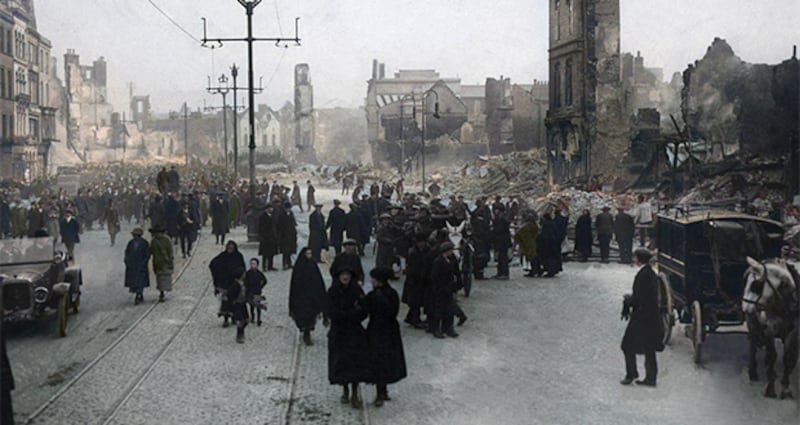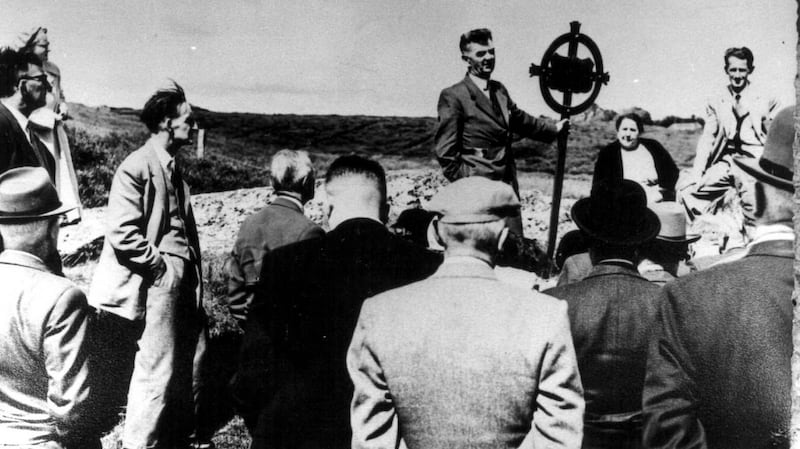On November 28th, 1920, a mobile patrol of Auxiliaries was ambushed and destroyed by an IRA flying column led by Tom Barry at Kilmichael, Co Cork. The Kilmichael Ambush changed the nature of Ireland’s War of Independence as it demonstrated the fighting capability of the IRA and led to the introduction of martial law in the south of Ireland. It was also just one of a series of actions in the campaign of guerrilla warfare Barry waged against the forces of the crown in west Cork, a campaign which continues to be studied by military personnel all over the world.
The son of a RIC constable and a British army veteran of the first World War, Thomas Bernadine Barry was an unlikely rebel. While his IRA activities have been well-covered by historians, relatively little is known about the factors that led him to embark on the road to rebellion. However, an examination of contemporary newspaper reports and other documents can provide many of the missing details.
On the night of September 7th/8th, 1940, a German incendiary bomb hit the Army Records Centre in London, causing a fire that destroyed most of its first World War army service records. Tom Barry's was among those that were damaged, but survived. His record, which is now held in the National Archives in Kew, shows he joined the British army on June 30th, 1915, and was given the service number 100399. After completing his basic training in Athlone, he was posted to the 114th Battery, 4th Brigade, Royal Field Artillery. He joined that unit in Mesopotamia on January 21st, 1916, and he would remain in that theatre of operations until May 20th, 1918. During that time, his unit took part in a number of key engagements, including the unsuccessful attempt to relieve the besieged city of Kut. Barry went on to spend eight months in Egypt and on March 7th, 1919, he was demobilised in the United Kingdom and transferred to the Class Z Reserve. He then returned to the family home at Convent Hill in Bandon, Co Cork.

Wartime service
Barry’s record also reveals other interesting details about his wartime service. The highest rank he held was bombardier, but on May 26th, 1916, he reverted to the lower rank of gunner “at his own request”. A glance at his conduct sheet shows he was found guilty of a number of offences, including being absent from parade, giving an improper reply to an NCO, creating a disturbance and “uttering a falsehood”. The punishment awarded for those misdemeanours included a reprimand and Field Punishment No 2, which involved being placed in fetters and handcuffs for a fixed period each day of the sentence.
Many of these details are well-known to historians. However, other notations on Barry's record have been ignored. According to one document, he was awarded a 40 per cent disability pension for malaria and 'DAH'. Those initials stand for the condition known as disordered action of the heart. During the war, this was also known as "soldier's heart", but today it is known as post-traumatic stress disorder. Barry's pension commenced on August 7th, 1919, and was scheduled to be reviewed in 66 weeks from September 3rd, 1919. His initial weekly payment was 11 shillings per week but this was later raised to 16 shillings. Other contemporary records held by the Western Front Association show the pension was renewed on four occasions and continued to be paid until at least June 5th, 1923.
On his return to Ireland, Barry joined the thousands of unemployed veterans who were then flooding into the country. He also became a prominent member of the Bandon Branch of the National Federation of Discharged and Demobilised Sailors and Soldiers (NFDDSS), an organisation formed in 1917 by the Liberal MP James Hooge to lobby for better conditions for ex-servicemen. On November 8th, 1919, he addressed a large meeting of veterans in Cork City Hall and successfully proposed a motion protesting against "the keeping in Government and War Department employment, civilians who, under no circumstances whatever would serve in the navy or army, no matter how great the need", and calling upon those responsible to have such men replaced by "discharged and demobilised men".
Failure to secure government employment
Barry's motion may have come as a result of his own failure to secure government employment. According to his biographer, historian Meda Ryan, in 1919 Barry entered Skerries College in Cork to study "Law, English and Business Affairs". However, his service record shows he also sought a position in the British civil service that year. An entry on the 'Inside Sheet', which records reasons why the record was removed from storage for consultation, reads: "Forwards Civil Service Commission Form for completion & return." The outcome of his application is not shown on his record but a document held in the National Archives in Kew states that in 1919, a "T. B. Barry" failed to pass an examination for the position of "Male Clerk, Ministry of Labour, Reconstruction Scheme, Ireland Division". Another entry on his record, dated February 2nd, 1920, reads: "Asks Indian Posting". Though no further information is shown, this probably indicates that Barry sought a government position in India.

By the beginning of 1920, the campaign for better conditions waged by Barry and his fellow veterans had met with little success. Ignored by the “King and Country” they had fought for, many now turned to politics while others expressed support for the radical and separatist politics of the Republican movement. In the municipal elections held in Cork on January 15th, 1920, 14 members of the NFDDSS ran on an ex-serviceman’s ticket and three were elected to Cork Corporation. These councillors subsequently supported the election of Tomás Mac Curtáin as the first republican lord mayor of Cork. A large group of ex-servicemen would also march in Mac Curtáin’s funeral procession after he was shot dead in his home by extremist elements of the RIC in the early hours of March 20th, 1920, and were thanked by his widow for doing so. They also marched in the funeral procession of lord mayor Terence MacSwiney after he died on hunger strike on October 25th, 1920.
Notwithstanding its success in the Cork municipal elections, all was not well with the NFDDSS in other parts of the county, and in the winter of 1919/20, the Bandon Branch was dissolved. Not all members were happy with this development and on June 10th, 1920, a meeting was held in Bandon to re-establish it. Barry was in attendance but he seems to have lost faith in the branch. A newspaper report states he described it as “lazy and sleepy” and opposed its re-establishment. He was also critical of attempts then being made to bring ex-servicemen into politics and declared he “would not become the tool of any political party”. Before the meeting ended, Barry proposed establishing a branch of an organisation called the “Ex-Servicemen’s Association”, but he failed to get a seconder.
‘Bit of a hiding’
Despite this setback, Barry continued to associate with his fellow ex-servicemen, many who now viewed the British army as their enemy. According to Meda Ryan, Barry also had his own reason to dislike his former comrades in khaki. In her book, Tom Barry: IRA Freedom Fighter, she writes that Barry got a "bit of a hiding" when he and a companion were stopped and questioned by British troops in Bandon. No doubt Barry was also outraged by what occurred when a group of veterans clashed with soldiers from Victoria Barracks near the North Gate Bridge in Cork on July 18th, 1920. During that altercation, John Bourke, a former Royal Munster Fusilier and member of the NFDDSS, was bayonetted to death. Two days later, more than 5,000 ex-servicemen marched in Bourke's funeral procession and among those listed in the newspapers as being a member of the guard of honour was "T. Barry" from Bandon. The funeral of John Bourke was Tom Barry's last known activity with his fellow ex-servicemen. That summer, he approached Seán Buckley, a member of the Bandon Company of the Irish Republican Army, who brought him into the organisation.
In his book, Guerilla Days in Ireland, published in 1949, Barry traces his decision to join the IRA to what he describes as his "rude awakening", which occurred in Mesopotamia in May 1916 when he read a communiqué containing details of the Easter Rising. While he goes on to say that on his return to Ireland, he "read avidly the stories of past Irish history" and "the daily papers, weekly papers, periodicals and every available republican sheet", he makes no mention of his activities with the NFDDSS, the fact that he applied for employment with the civil service or was awarded a disability pension. This is understandable, but in reality, he was just one of thousands of veterans all over Europe whose military service and post-war experiences would shape the decisions they made when they returned home.
Scarred by his wartime service, physically abused by men in khaki, angered by the treatment of ex-servicemen, unable to secure government employment and inspired by the Easter Rising, in the summer of 1920 Tom Barry made a decision that would change both his life and the nature of the conflict then raging in Ireland. His transition from gunner to guerrilla was now complete. Though he returned home a veteran, his fighting days were far from finished.
Gerry White is the co-author with Dr Brendan O’Shea of The Irish Volunteer Soldier 1913-1916 (Osprey UK, 2003) and Baptised in Blood: The Formation of the Cork Brigade of Irish Volunteers 1913 - 1916 (Mercier Press, 2005)





















